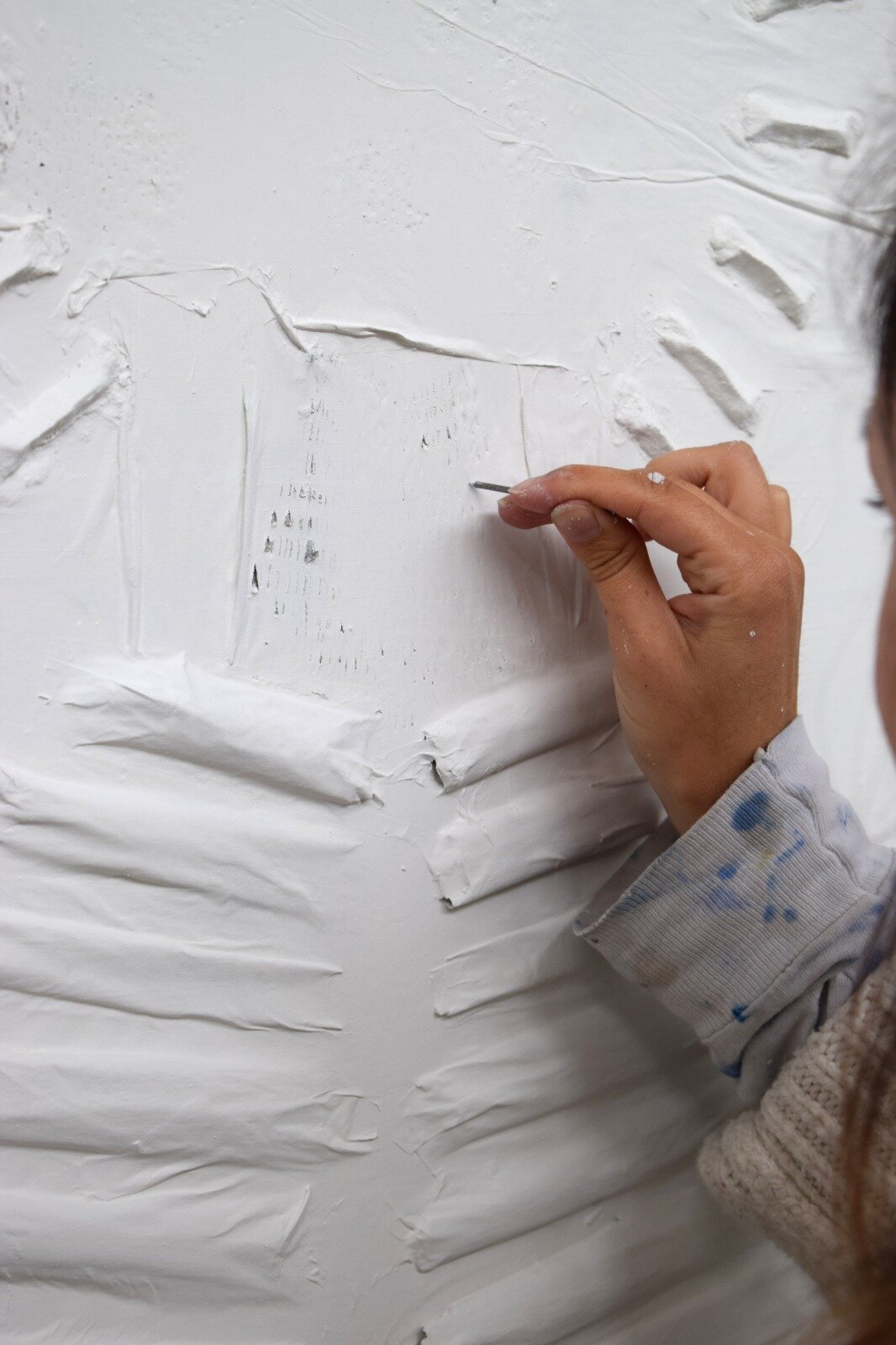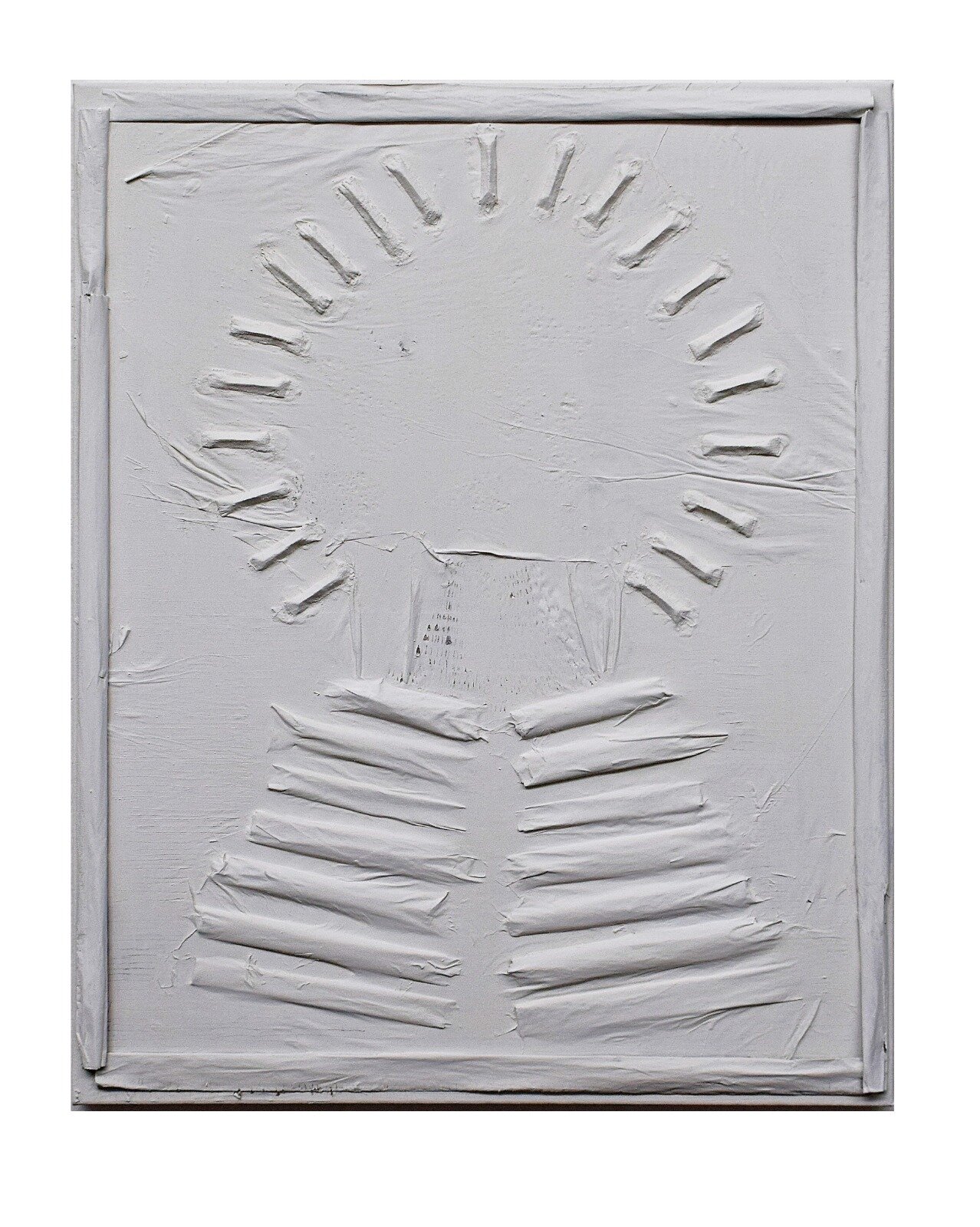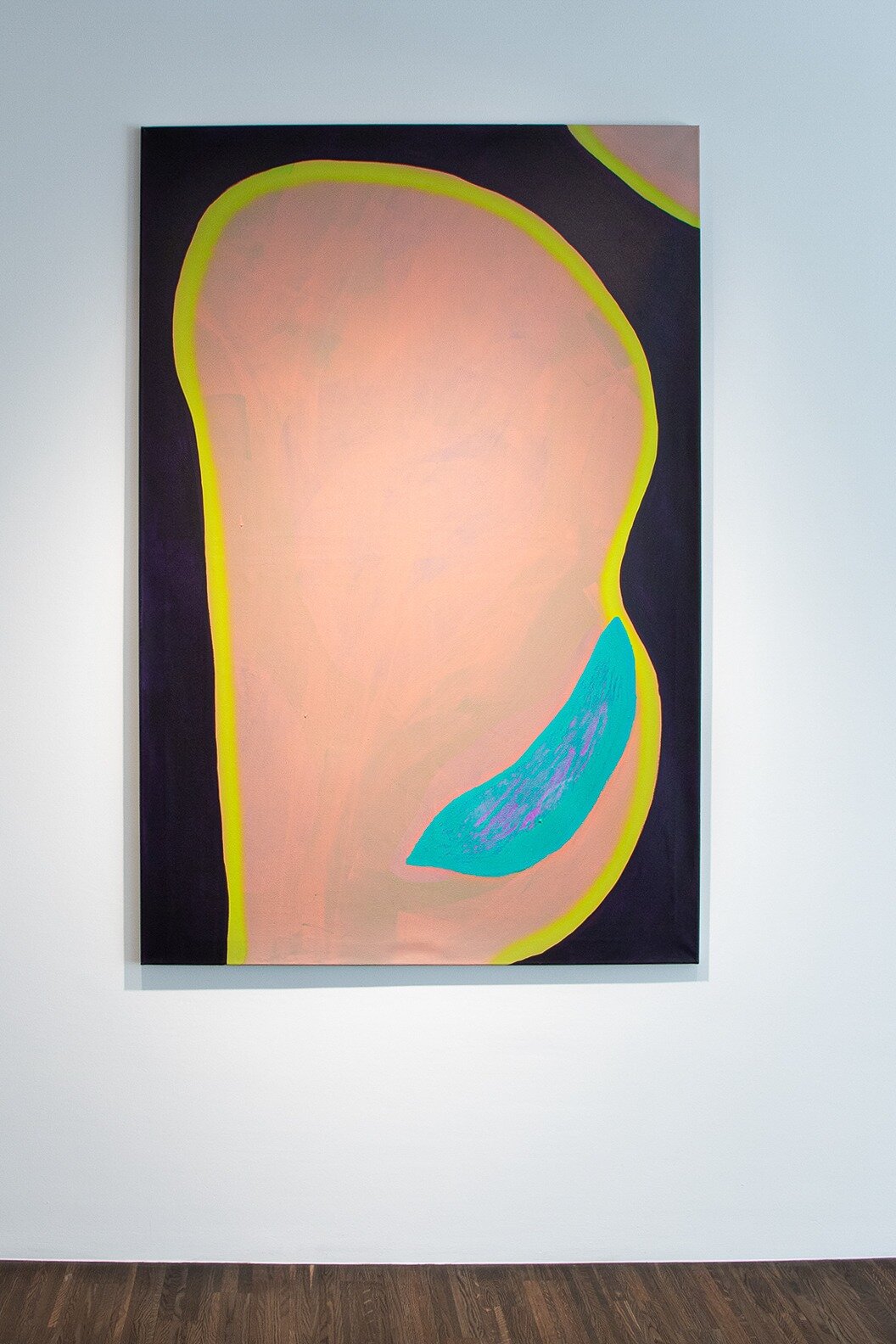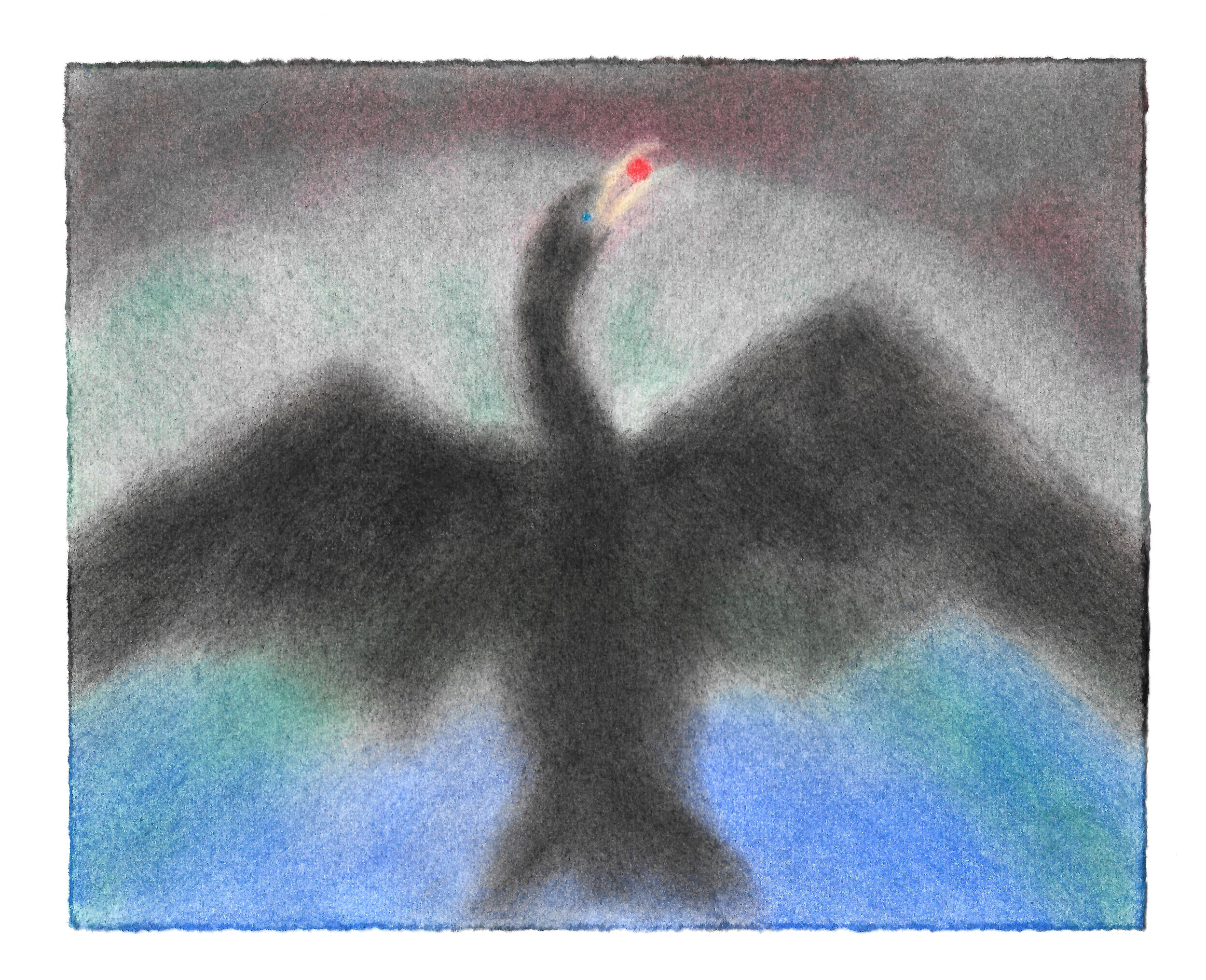Happy Women’s History Month. Women in Art
We are immensely proud to be working with 13 amazing female artists (out of 18 artists in total) in our first Studi0 Edition. Representation of women in the art world is, still today, a hot topic that needs to be addressed and we will get into this in another Editorial, but for now we want to celebrate these 13 talented women - please meet:

























Maddie Rose Hills (UK)
https://www.maddierosehills.co.uk/
Maddie Rose Hills (b.1993) is an artist living and working in South London. She has exhibited in London, Paris and Barcelona, and undertaken residencies in London and Iceland. Her work is in the British Airways Public Collection as well as private collections in France, Poland and London. Hills' work explores time and memory using the medium of paint and found materials to create layers that conceal and reveal existing marks. The paintings, each taking between a month and a number of years to create, often explore perception and memory relating to place; be that a landscape or space that she has spent time in. An interest in the materiality of paint is at the fore of Hills' practice.
(source: https://www.maddierosehills.co.uk, 2021)
Shannon Zwicker (CH)
https://www.shannonzwicker.ch/
Shannon Zwicker understands her work as a passionate search for form. She enjoys letting structures and forms grow, relating surfaces and lines to each other, making them disappear and then bring single elements back to the surface again. In this way, openings are created that refer to a hidden interior.
She mixes different techniques of painting and drawing and uses a colour spectrum which is often oriented within a tonality of the carnat, as used to depict naked human body parts, combined with complementary and gaudy contrasting colours. The result is a gestural painting populated by fluid forms that are neither entirely abstract nor visibly figurative.
Her work is driven by a basic interest in corporeality and related questions of volume, surface, form and colour. They are based on a deep engagement with current debates about body normativity, gender, desire, but also with pop culture and feminism. At the same time, they have an inherent reflexive character, which is based on the attempt to capture one's own body awareness. The works tell of longing and desire, of sensuality and touch.
(source: S.Zwicker in conversation with Studi0, 2020)
Vika Prokopaviciute (AU)
Swirling abstract forms and refined mark making, a strong dialogue ensues between the work and the artist as the work forms itself architecturally. In a continuous process Prokopaviciute defines painting rules and orders in an almost mathematical way. In her own words:
“A painting, like a vessel, preserves the information that is necessary to paint another one: how it might look from the other side, how it might be inside, what it might be. One painting leads to another. And it goes on and on, paintings are painted, and paintings paint themselves. A branch just wants to go on branching, a painting only wants to go on painting. The process turns on a weird ‘painting machine’, which spins round in front of you and me, generating more paintings”.
(source: V. Prokopaviciute in conversation with Studi0, 2020)
Una Ursprung (TW)
Una Ursprung makes works that are mostly painting, collage and photography, focusing on forests and natural scenery. Initially she chose a sort of floating line style, using ribbons of spray paint to represent the colorful effects of lighting, but in quiet, serene, beautiful settings: in the woods. Every touch of brush reflects how nature, and forest environments, make her think and feel. In her words: “But because we mostly see spray paint in the city, its contrast in my paintings speaks to human intervention in the ecosystem. I try to find the balance between the ecological and the artificial on the canvas, just like how we as people need to find balance with our environment.”
(source: U. Ursprung in conversation with Studi0, 2020)
Helen Waldburger (UK)
https://www.helenwaldburger.com/
Helen Waldburger (b.1993) is an artist born and raised in Zurich. She completed her BA in Fine Arts at Central Saint Martins in 2018 after which she worked as an artist full time in London and in 2020 also started an artist run nomadic Gallery. In her own words: “I paint inspired by the concept of moving images with light and shadow. The shadows and the light are created through a balancing act between different mediums such as watercolour, oil, oil pastels and the implementation of the cotton organdy that allows to create two planes on one wooden stretcher bar. These two planes allow me to almost recreate a sense of a stage design, with foreground and background. The translucent cotton organdy also reflects on a sense of honesty, seeing through something or someone. I enjoy conjuring stories of the everyday, myths, witches and especially stories of women”.
(source: H. Waldburger in conversation with Studi0, 2020)
Miranda Forrester (UK)
https://mirandaforrester.portfoliobox.io/
Miranda Forrester is a figurative painter from London. Forrester’s practice explores the queer black female gaze in painting, relating to the history of men painting womxn naked. Forrester’s work is concerned with addressing the invisibility of women of colour in the history of art and combating the fetishization of these bodies. Forrester’s work investigates how her paintings can rearticulate the language and history of life drawing through a queer black feminist desiring lens, and in doing so, depict what the male gaze cannot see. Her use of stretching plastic over stretchers and painting on highly primed smooth surfaces is fundamental to the work, in that the viewer can see through the bodies; the surface becomes more than skin, they are flesh, real and alive, bare and on display. The work, altogether, is a celebration of women's bodies, the joy in occupying feminine identities and being in relation with one another.
(source: https://mirandaforrester.portfoliobox.io/drawings, 2021)
Omer Halperin (IL)
As the cloud of charcoal settles faces reveal themselves, staring back at you - possessing no emotion and yet all of them at the same time, for Halperin, painting and drawing are acts of intimacy.
Halperin was born in 1984, she lives and works in Tel Aviv, Israel. In her own words” In my work I am trying to connect with my inner world, my feelings and memories and convey them to the world outside.
The medium of drawing allows me to work fast without any preparations, trying to make my work process unconscious. Most of my works are made with one substance only, natural carbon sticks, which these days, compared to other substances and art materials, is affordable.
I don't know who the person or the figure is I paint. I don't refer to them as women or men. Their gender is vague because there is no dominant presence of their bodys. It also has to do with the mouth and how I paint it, it is almost generic and most of the time it's a simple line. I believe that the lack of the mouth also increases the vagueness of the body itself”.
(source: O. Halperin in conversation with Studi0, 2021)
Yulia Iosilzon (UK)
“ London-based, Russian-born artist Yulia Iosilzon (b.1992) paints stories that are sprung from imagination and given life in delectable colour. Interrogation of colour and narrative form the basis of her work, which explores themes of excess and overconsumption in society through celebration and tradition. The artist invites us to celebrate with her through dynamic scenes of feasts, birthday parties and social gatherings. To participate in a never-ending party with the promise of eating too much cake until you feel sick and listening to a happy song stuck on repeat. In paintings such as Cutting the Cake, beaming faces and giant party hats trap the viewer in their embrace. Purity of pleasure becomes a childlike experience, but to believe in its childlike nature is to be misinformed. Like a layered birthday cake, irony and humour lurk beneath the painted surface, hinting at social unrest.”
(source: C. Bowes, Studi0 Wintermarathon, 2021)
Irene Gazzillo (CH)
https://www.irenegazzillo.com/
Fragility, in all its many forms, is both a worry and a truth; a constant fear and a prevailing reality. The fear and inevitability of fragility is something that is routed at the heart of sculptor and installation artist, Irene Gazzillo’s practice. Whether examining the fragility of material or delving into the fear of the unknown that permeates the human psyche, Gazzillo creates work to expose the existence of fragility in everything from the practical to the psychological.
Gazzillo’s poetic musings of space form installations that immerse and envelop the viewer. With her considered approach to form, light, medium and space, Gazzillo investigates the way in which the fear of fragility is presented unto us and manifests itself as an underlying insecurity. Commenting on the linear patterns of life and the uncertainty that infiltrates our decision making, Gazzillo explores how as humans we are forever on the precipice of fragility whilst simultaneously in the midst of it.
(source: T. Martin, Studi0 Wintermarathon, 2021)
Lihi Turjeman (IT)
Lihi Turjeman’s large-scale installations penetrate layers of lime and plaster, geography and history. Through intense labor, digging through walls, mixing materials and transferring layers of paint, she maps territories and reveals layers of personal and public history, at times hidden from the eye. In a constant search for built and imagined architectures, past histories and current narratives, the source, the center and the center of gravity, she documents constant decay, urban, social and human.
(source: http://lihi-turjeman.com/wp-content/uploads/2020/10/cv-2020.pdf, 2021)
Manon Steyaert (UK)
https://www.manonsteyaertart.com/
Steyaert’s practice is predominantly based around the mediums of painting and sculpture, she aims to change the viewers perceived notions of each medium by bridging them close together, creating a blur or a sense of limbo between mediums, her paintings act as sculptures and sculptures as paintings. Using non-traditional materials, such as silicone, latex and cellophane, with painting, she is currently focused on pouring it herself, enabling her to be able to create a material from scratch to alter it from its beginning.
She uses brightly coloured layers to create a sort of interruption in the space where the work is shown, enticing the viewer to analyse the surface of the works and become confused on how their gaze is “stolen” away from them through curiosity. Wanting to originally work in Fashion, Steyaert finds inspiration from fabrics and their possibilities to create forms, relating this to the canvas on a stretcher and the relationship between form and structure, wanting to see her materials live on their own, standing on their own “feet” away from the canvas frame, Steyaert has been exploring this through the medium of instillation with larger silicone works.
(source: https://www.manonsteyaertart.com/cv.html, 2021)
Mary Herbert (UK)
Mary’s (b.1988) work is an intuitive exploration of memory and sensation. Working at the intersection of drawing, painting and printmaking, she creates subtle and enigmatic works which oscillate between the recognised and the unknown. Her current work is a series of small, dream-like pastel drawings formed of a composite of feelings, lived-sensation, unconscious processes and observation. Mary studied art at Goldsmiths College in London, where she developed a fascination with the materiality of the photographic image and it’s unreliability as a container of memory, and later at the Royal Drawing School where she re-connected with the physical and unconscious aspects of image making through drawing.
(source: http://mary-herbert.com/bio , 2021)
Valerie Savchits (UK)
https://www.valeriesavchits.com/
Valerie Savchits (b. 1993)
Growing up in a working-class family in post-Soviet Latvia, Savchits witnessed a country that was unwilling to embrace progress, which made thinking outside the box and rejecting traditional views an important step in her artistic journey. Thus, the artist's undergraduate research focused on the concept of ugliness and its position in art and culture. In his book, Aesthetic of Ugliness, Rosenkranz emphasizes three main types of ugliness: formlessness (amorphousness, asymmetry, disharmony), incorrectness, and deformation. These types became the core of Savchits' creative practice, making her bold and fearless with the messages she portrayed through her work as she deviated from the norms and rules she learned in school. Valerie's work invites viewers to immerse themselves in a world where humanity has failed to fight its own apathy and indifference, a world where fiction becomes reality and a cult of ignorance consolidates its position.
Taking inspiration from dystopian sci-fi, star atlases and illustrations from science and nature books, her work is also accompanied by text in the form of diary entries and excerpts from Russian literature. Savchits' body of work primarily consists of two-dimensional work as well as experimental sculptures made of a vast array of materials including but not limited to: clay, raw minerals, wood and metal.
(source: https://www.valeriesavchits.com/about, 2021)

